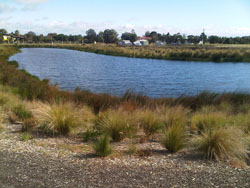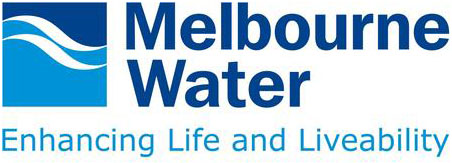resource library
Array
Grinter Wetland Planting - June 2012

Grinter Wetland Construction - February 2011

Kardinia Park – Construction of underground storage tank
Geelong Stormwater Harvesting Projects
City of Greater Geelong
Kardinia Park , Geelong, Victoria | Map:
Published: 29 March 2012
Project Overview
The City of Greater Geelong has embarked upon a number of stormwater harvesting projects to reduce its potable water use and maintain green open space and recreational assets. Two of these projects are detailed below.
Kardinia Park is an open space precinct that includes Simonds Stadium, home to the Geelong Football Club, and a number of other football/cricket ovals. The precinct is an important asset in the sporting and cultural identity of the Greater Geelong. The system diverts runoff from stadium roofs, playing fields and a stormwater pipe draining a 30 hectare suburban area of Newtown. The water is filtered through a Gross Pollutant Trap and is then stored in a 1.7ML underground tank. The storage tank contains 1km of semi-circular plastic chambers and 4000 tonnes of rock encased in a high density plastic liner. Water is drawn from this tank and used to irrigate the AFL ground’s playing surface and other surrounding ovals. Before irrigation however, the water is further filtered through a screen filter (200 micron) and disinfected using UV light. To ensure the quality of the water is adequate for the high profile sporting fields several safeguards have been included on the system including; oil/fuel detection probe, salinity probe, automated shutoff sluice gates, and a control system that will send alarms to mobile phones if something goes wrong.
Grinter Reserve was a product of the City's Sustainable Water Use Plan developed or established in 2006. Stormwater from a conventional drainage system from an adjacent 200ha residential suburb is diverted into a constructed wetland in Grinter Reserve. Additional water sourced from the 'Splashdown' aquatic facility located within the Reserve allows approximately 30 megalitres of cleaned water to supply 100% of the irrigation demand for the reserve, providing ecological habitat and amenity and eliminating the need for potable water. The Grinter Park Wetland & Stormwater Harvesting project won the 2011 CCF earth award - Category 1.
Drivers and Objectives
Kardinia Park’s main objective was to reduce the precinct’s reliance on potable water and allow the use of ‘fit for purpose’ water to irrigate the playing fields. This would allow the stadium fields to be watered all year round in order to maintain a high quality surface for AFL matches.
Grinter Reserve was identified as one of the City's largest users of water. The primary goal was to secure a reliable alternative water source to irrigate the playing fields at Grinter Reserve, to 'drought proof' the sporting facilities and provide appropriate quality water to other assets within the Reserve. This will allow effective ongoing maintenance of these assets and the clubs, and save potable water for high quality use.
Organisations
City of Greater Geelong (Responsible Council)
Australian Government - Water for the Future (Funding Partner)
Victorian Government (Funding Partner)
Geelong Football Club - Kardinia Park (Stakeholders)
Parsons Brinkerhoff (Design Consultant - Kardinia Park)
Cardno Grogan Richards (Design Consultant - Grinter Reserve)
Project Outcomes
- Kardinia Park has reduced its potable water demand by 13ML, which corresponds to 90% of the irrigation needs for the AFL standard oval and two other nearby ovals.
- The underground storage cells at Kardinia Park have been constructed to allow bus parking on the ground surface, making effective use of high value open space.
- Grinter Reserve has been able to eliminate all potable water use on the sports fields and provide additional water for irrigation thereby increasing the potential for new facilities to be established and encourage the local community to become physically active and socially connected.
- Grinter Reserve has been transformed into an attractive, social and educational precinct including walking paths, interpretation signage and improved habitat for local indigenous flora and fauna.
Lessons Learnt
Kardinia Park:
- The Kardinia Park project had to overcome a high level of risk aversion due to its high profile and cultural sensitivity. Effective research into products, suppliers, technologies and design methods was critical to providing an effective outcome.
- Issues were encountered onsite due to unreliable information about the location and depth of existing services and meant that modifications were required during the construction phase. A solution to this is a ‘Dial Before You Dig’ approach, as well as pot-holing and hydro-excavation in the planning and design phase of the project to verify the exact location and depth of services.
- On-going maintenance requirements, including the skills and knowledge needed to undertake the maintenance, and the cost involved, is a vital component that needs to be budgeted for. Handover of the project should include a maintenance program which details all elements of the system: trigger points, programmed maintenance requirements and maintenance costs. When taking over a project, maintenance responsibilities need to be assigned. Checklists are a great tool for staff to use.
Grinter Reserve:
- At Grinter Reserve the nature of the site and the groundwater resulted in some pre-construction design changes. The initial design sat within a lined basin in saline groundwater. Design changes to elevate the wetland above the saline groundwater reduced the risk of saline water ingress into the system.
- The sand used in the filtration system at Grinter Reserve contained a high level of leachable iron. The high levels of iron were toxic to the grass that was to be irrigated and as such the sand was removed and replaced. All sand filters should be subjected to a leachate test before being considered for a filter bed.
- Communicating the design and appearance of the system to stakeholders was challenging. For a large part of the year the system is submerged beneath the water. However, in late summer areas of sediment are visible and may be considered unsightly. To mitigate the effects an inspection and maintenance regime is in place.
Project Cost
Grinter Reserve total project - $860,000
Kardinia Park total project - $1.1 Million (Investigation - $100,000, Design - $100,000, Construction - $900,000)
Timeframe
March 2010 to April 2011
Contact
Anne Miller - City of Greater Geelong
P: 03 5272 4565
E: amiller@geelongcity.vic.gov.au
